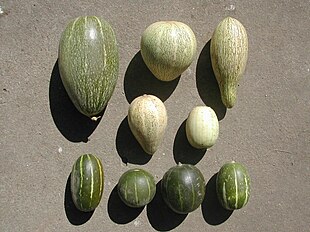
Cucurbita is a genus of herbaceous fruits in the gourd family, Cucurbitaceae, native to the Andes and Mesoamerica. Five edible species are grown and consumed for their flesh and seeds. They are variously known as squash, pumpkin, or gourd, depending on species, variety, and local parlance. Other kinds of gourd, also called bottle-gourds, are native to Africa and belong to the genus Lagenaria, which is in the same family and subfamily as Cucurbita, but in a different tribe. These other gourds are used as utensils or vessels, and their young fruits are eaten much like those of the Cucurbita species.

A melon is any of various plants of the family Cucurbitaceae with sweet, edible, and fleshy fruit. The word "melon" can refer to either the plant or specifically to the fruit. Botanically, a melon is a kind of berry, specifically a "pepo". The word melon derives from Latin melopepo, which is the latinization of the Greek μηλοπέπων (mēlopepōn), meaning "melon", itself a compound of μῆλον (mēlon), "apple", treefruit " and πέπων (pepōn), amongst others "a kind of gourd or melon". Many different cultivars have been produced, particularly of cantaloupes.

Cucurbita pepo is a cultivated plant of the genus Cucurbita. It yields varieties of winter squash and pumpkin, but the most widespread varieties belong to the subspecies Cucurbita pepo subsp. pepo, called summer squash.

Calabaza is the generic name in the Spanish language for any type of winter squash. Within an English-language context it specifically refers to the West Indian pumpkin, a winter squash typically grown in the West Indies, tropical America, and the Philippines. Calabaza is the common name for Cucurbita moschata in Cuba, Florida, Puerto Rico, and the Philippines. C. moschata is also known as auyama in Colombia, the Dominican Republic and Venezuela; ayote in Mexico and Central America; zapallo in certain countries of South America; and "pumpkin", "squash", or "calabash" in English-speaking islands.
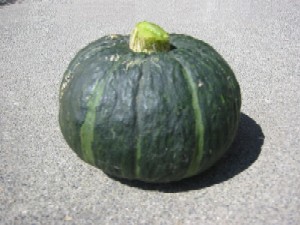
Kabocha is a type of winter squash, a Japanese variety of the species Cucurbita maxima. It is also called kabocha squash or Japanese pumpkin in North America. In Japan, "kabocha" may refer to either this squash, to the Western pumpkin, or indeed to other squashes. In Australia, "Japanese pumpkin" is a synonym of Kent pumpkin, a variety of winter squash.
Straightneck squash is a cultivated variety of Cucurbita pepo grown as a type of summer squash that is usually yellow-colored. It is also known as yellow squash, though other squashes, such as crookneck squash, may also be known by that name. It has mildly sweet and watery flesh, and thin tender skins that can be left on the fruit for many types of recipes. It was almost certainly domesticated in the eastern United States, although other variants of the same species were domesticated in Mesoamerica. This squash grows on vined plants reaching 60–90 cm (2.0–3.0 ft) in height that thrive in mild weather. It is well known as an item in American cooking where it is fried, microwaved, steamed, boiled, or baked. It is often used in recipes interchangeably with zucchini. A good yellow summer squash will be small and firm with tender skin free of blemishes and bruising. It is available all year long in some regions, but is at its peak from early through late summer. One similar inedible C. pepo variety is C. pepo var. ovifera.

A pumpkin seed, also known in North America as a pepita, is the edible seed of a pumpkin or certain other cultivars of squash. The seeds are typically flat and oval with one axis of symmetry, have a white outer husk, and are light green in color after the husk is removed. Some pumpkin cultivars are huskless, and are grown only for their edible seed. The seeds are nutrient- and calorie-rich, with an especially high content of fat, protein, dietary fiber, and numerous micronutrients. Pumpkin seed can refer either to the hulled kernel or unhulled whole seed, and most commonly refers to the roasted end product used as a snack.

Cucurbita ficifolia is a species of squash, grown for its edible seeds, fruit, and greens. It has common names including Asian pumpkin, black seed squash, chilacayote, cidra, fig-leaf gourd, and Malabar gourd. Compared to other domesticated species in its genus, investigators have noted that samples of C. ficifolia from throughout its range are relatively similar to one other in morphology and genetic composition. Variations do occur in fruit and seed color, some isozymes, and photoperiod sensitivity.

Cucurbita moschata is a species originating in either Central America or northern South America. It includes cultivars known as squash or pumpkin. C. moschata cultivars are generally more tolerant of hot, humid weather than cultivars of C. maxima or C. pepo. They also generally display a greater resistance to disease and insects, especially to the squash vine borer. Commercially made pumpkin pie mix is most often made from varieties of C. moschata. The ancestral species of the genus Cucurbita were present in the Americas before the arrival of humans. No species within the genus is fully genetically isolated from all the other species. C. moschata can be hybridized with all other species. It has been suggested that this shows that the species of Cucurbita have diversified more recently than those of related genera such as Cucumis and Citrullus.
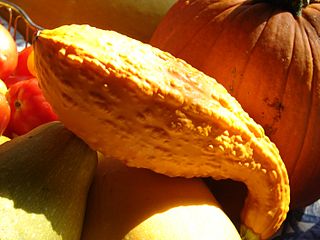
Crookneck squash, also known as yellow squash, is a cultivar of Cucurbita pepo, the species that also includes some pumpkins and most other summer squashes. The plants are bushy and do not spread like the plants of winter squash and pumpkin. Most often used as a summer squash, it is characterized by its yellow skin and sweet yellow flesh, as well as its distinctive curved stem-end or "crooked neck". It should not be confused with crookneck cultivars of Cucurbita moschata, such as the winter squash 'Golden Cushaw', or the vining summer squash 'Tromboncino'. Its name distinguishes it from another similar-looking variety of C. pepo, the straightneck squash, which is also usually yellow. There is one similar non-edible C. pepo variety: C. pepo var. ovifera.

Delicata squash is a variety of winter squash with cylindrical fruits that are cream-coloured and striped in green or orange. As its name suggests, it has characteristically a delicate rind. It is also known as peanut squash, Bohemian squash, or sweet potato squash. It is a very sweet variety with a thin, edible skin and is typically cut into half rounds and roasted. It is a cultivar of the species Cucurbita pepo, which also includes the summer squash varieties pattypan squash, zucchini, and yellow crookneck squash, as well as winter squash varieties including acorn squash, spaghetti squash, and most pumpkins used as Jack-o-lanterns.

Winter squash is an annual fruit representing several squash species within the genus Cucurbita. Late-growing, less symmetrical, odd-shaped, rough or warty varieties, small to medium in size, but with long-keeping qualities and hard rinds, are usually called winter squash. They differ from summer squash in that they are harvested and eaten in the mature stage when their seeds within have matured fully and their skin has hardened into a tough rind. At this stage, most varieties of this vegetable can be stored for use during the winter. Winter squash is generally cooked before being eaten, and the skin or rind is not usually eaten as it is with summer squash.

A pumpkin, in English-language vernacular, is a cultivated winter squash in the genus Cucurbita. The term is most commonly applied to round, orange-colored squash varieties, though it does not possess a scientific definition and may be used in reference to many different squashes of varied appearance.
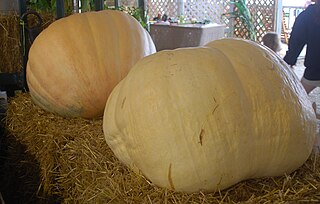
Big Max is a large type of pumpkin of the species Cucurbita maxima that can exceed 150 pounds (68 kg) under ideal growing conditions. They are often bright orange in color, with fine-grained, yellow-orange flesh. The skin, deeply ribbed and slightly roughened, can grow to be 3 to 4 in thick, making them favorable for storage. The flesh has been described as good for canning and freezing. However, their size often makes utilizing them for culinary uses cumbersome, and they lack the flavor and texture present in smaller pumpkin varieties.
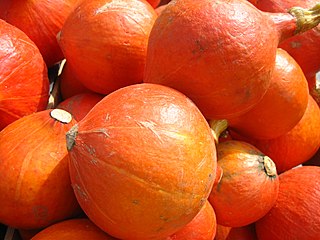
Red kuri squash is a thin skinned orange colored winter squash, a cultivated variety of the species Cucurbita maxima. It looks like a small pumpkin without the ridges. It belongs to the Hubbard squash group.
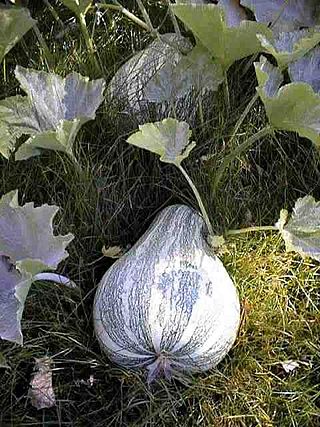
Cucurbita argyrosperma, also called the cushaw squash and silver-seed gourd, is a species of winter squash originally from the south of Mexico. This annual herbaceous plant is cultivated in the Americas for its nutritional value: its flowers, shoots, and fruits are all harvested, but it is cultivated most of all for its seeds, which are used for sauces. It was formerly known as Cucurbita mixta.
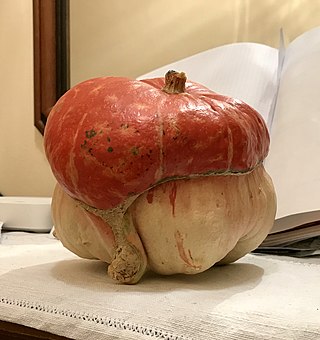
Turban squash, also known as "Turk's turban" or "French turban", is a type of squash most often used as a winter squash. It is an heirloom, predating 1820. A cultivar of Cucurbita maxima, it is closely related to the buttercup squash. It is typically 6 pounds when mature. Colors vary, but are often mottled in shades of orange, red, white and green. The squash is used as both a vegetable and as an ornamental gourd. Taste is similar to other C. maxima cultivars, though "not as vibrant," "reminiscent to hazelnut," and "coarse, watery and insipid." Known in the nineteenth century as "the most beautiful in color, and the most worthless in quality, of all the varieties of squash;" More recently, Ian Knauer, author of "The Farm", has described it as "nutty and sweet".
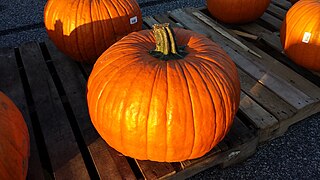
Connecticut field pumpkins are a type of pumpkin first attested in the 16th century. They are one of the oldest varieties of pumpkin in existence and are known as an heirloom plant. One of the most popular Halloween pumpkins, Connecticut field pumpkins are commonly used for autumn decorations and jack-o'-lanterns; a strain of Connecticut field pumpkins have been described as "the original commercial jack-o'-lantern pumpkin". Due to the variety's appearance and growth process, it is considered to be well-suited for ornamental use. It also has culinary uses, particularly in canning, and was used for medicinal purposes by Native Americans in the United States prior to European contact.

Honeynut squash is an interspecific hybrid winter squash cultivar bred from butternut and buttercup squash. It has dark tan to orange skin with orange fleshy pulp. When ripe, it turns from green to a deep orange and becomes sweeter and richer. Honeynut squash has a similar shape and flavor to butternut squash but averages about half the size and is sweeter. It has two to three times more beta-carotene than butternut squash. Honeynut squash can be roasted, sautéed, puréed, added to soups, stews, and braises, and has enough sugar content for desserts.


